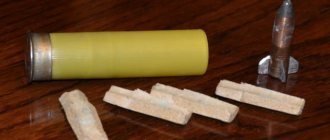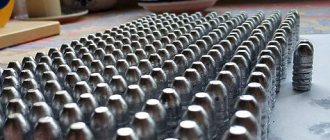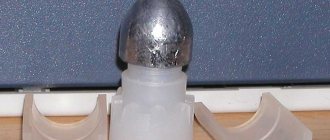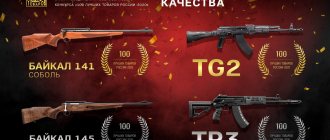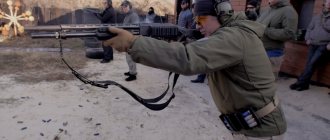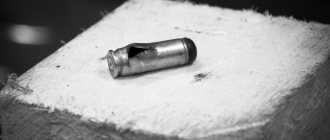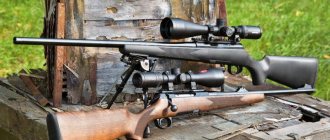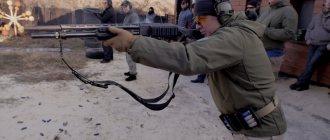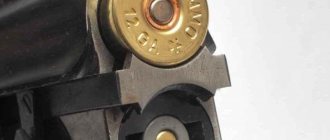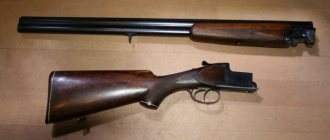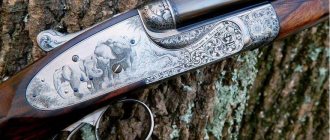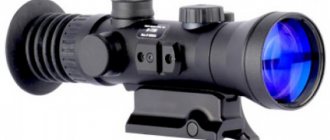Arrow bullets
From the name it is clear that an arrow shape was used for this type of construction. All models are equipped with a lightweight tail, which serves to stabilize them during flight. Due to the fact that the front part is made heavier compared to the back, it has a clear shift in the center of gravity towards the head. This affects the correct flight and prevents it from turning over.
Polev's bullet
The Polev bullet was created in the 80s in the Soviet Union. It is a striking element made of lead of small diameter, which is mounted on a plastic shank. In addition to the shank, the diameter of the bullet requires a special thick container for firing. This is necessary so that, unlike usual, it does not dangle. Due to these requirements, the Polev bullet is quite difficult to make on your own.
Used for hunting large animals: bear, wild boar, elk. There are steel and brass variations, but they are practically not common.
A distinctive characteristic of the model is decent accuracy at long and fairly long distances for a smoothbore gun. Up to 150 meters can hit the beast outright. However, the bullet is not suitable for shooting through thickets or bushes due to strong deflections when hitting even minor obstacles.
VVOO-Ilyin bullet
A domestically produced model, which has two parts: main and tail.
The main one is made in the shape of a monolithic cylinder and has a conically pointed appearance in front. Flat ribs are located along the axis of symmetry. The design also provides for a guide belt. The tail section has a lightweight polyethylene three-bladed stabilizer.
Practice has shown that it is the weakest link in the design of this model. It is so weak that during a shot it completely flies off under the influence of the impact force of the powder gases.
This directly affects the deviation of the bullet from the planned flight path.
Bullet Vyatka
This model is also composite in its structure. In appearance it resembles a drop. The model is equipped with 6 ribs that ensure its centering. The design of the model is quite compact and streamlined.
Bullet Diabolo Liman
The model is similar in appearance to match pneumatic bullets. Very famous among hunters who like to shoot for accuracy. The model belongs to the sub-caliber category. Its design ensures a low percentage of rebounds.
The model is easy to make at home, since quite a few manufacturers produce overclocking quality watering cans. The presence of this tool and simple design allows you to make a lot of Diabolo Liman pieces. Therefore, this type is better suited for hunters who like to shoot a lot and often.
Equipment
A 12 gauge Mayer bullet is loaded according to the recommendations of its creator. You need a paper cartridge case with a primer, into which two grams of gunpowder are poured. The primer used is Zhevelo, and the gunpowder is better than Sokol. The temperature should not be below -4 degrees Celsius. If the frost exceeds -20 degrees, then the amount of gunpowder can be increased by one tenth. The weight of a 12 gauge bullet is 33-34 grams, this is what you need to focus on. Next, you need to add cardboard gaskets with a total thickness of about three millimeters to the gunpowder, after which you need a felt wad half the diameter of the barrel, which is cut into four parts in height.
You need to pour small sawdust onto the felt, on which to place a cardboard wad a little more than half a centimeter thick. Next comes a three-millimeter cardboard spacer with a diameter exactly the same as that of the bullet body, not counting the ribs. Such equipment must be located exactly centrally in the sleeve tube. After this, you need to lower the bullet as carefully as possible, without displacing the thick cardboard wad. The sleeve can now be rolled. The sawdust layer should leave about five millimeters for this.
Turbine bullets
In comparison with round, pointer and pointer-turbine ones, this type has the most advanced design. The models are distinguished by the best performance in accuracy and consistency of combat. This is influenced by their structure, which ensures very fast rotation in flight. Its structure is monolithic. The body is made of lead, the head is made heavier than the tail.
In the center there is a through channel, which has the shape of a cylinder or cone. Inside the channel itself there are spiral blades. This is done so that the air flow passing through this channel contributes to stable flight. And the blades, rotating under its influence, increase stability.
Mayer's bullet
This domestically produced model is the most popular among hunters in the turbine category. Its technical feature is that the Mayer bullet, leaving the barrel of the weapon, already begins to rotate. The body has two cylinders connected to each other by a conical transition. The target combat distance is 130-160 m. This model is characterized by a high level of lethality.
Responsibility
Loading a Mayer bullet is extremely important for successful hunting. Shooting with a bullet differs significantly from shooting, for example, with a shot, and therefore special care is required in equipping the cartridge so that the shot does not turn out to be false, but is effective. However, many hunters scold themselves after a miss due to a poorly loaded cartridge.
The method of loading a bullet cartridge should not be violated in any way. The most important thing is that you should not use someone else’s equipment, whose quality is unknown. And you must definitely try out your own made cartridges, and from the same gun with which you will go hunting.
Arrow-turbine bullets
To achieve high shooting accuracy, it is necessary to make the bullet as stable as possible during flight. This can be achieved by applying low aerodynamic fins placed in a spiral, or blades on a stabilizer shank. This technological solution, together with the use of the arrow principle, became the basis for the production of this modification of 12-gauge bullets.
Caliber arrow-turbine bullet "Gualandi"
Brenneke bullet
This model was created at the beginning of the 20th century in Germany. It has become widespread throughout the world for smooth-bore weapons. The Brenneke bullet has angled ribs that cause it to rotate when fired. Belongs to the caliber category. This means that the containers do not interfere with the contact between the inner surface of the weapon barrel and the ribs themselves.
With this model it is possible to kill almost any large wild animal, even a grizzly bear. In comparison with the Poleva model, it has a significant drawback - the shot accuracy is worse.
Flaws
Of course, the 12-gauge Mayer bullet also has drawbacks. Reviews say that they are most noticeable if the bullet is made homemade and of poor quality. For example, the lead used is too soft and does not contain additives to give it strength. In this case, you need to know exactly how to load the Mayer bullet. An increased charge of gunpowder will cause the bullet to tumble in flight, because it is crushed from overload during the shot, even the internal channel can close.
Naturally, a deformed bullet almost never marks. Only a sub-caliber bullet can help here. And in no case should the weight of gunpowder be exceeded. Another case is when the bullet material is too hard. This is much worse, since there is a risk of damaging the barrel. Another drawback is that even if the Mayer bullet is cast correctly and always loaded correctly, it will deflect in flight due to interference. Bushes, as well as tree branches, and any natural obstacle can interfere with its accurate flight.
Round bullets
This type is characterized by a simple structural system; their bodies are most often made monolithically. The center of gravity is located in the middle.
Spherical (ball) bullet
It is considered the most ancient. In appearance it is an ordinary ball, the diameter of which can vary according to your wishes. For those who make bullets with their own hands, it will not be difficult to make it. This model can be:
- caliber;
- sub-caliber.
The material for the manufacture of the caliber modification is pure lead. Its physical properties provide the model with minimal friction when passing along the barrel of a weapon. Has the following characteristics:
- stability in flight to the animal;
- small obstacles (grass, thin twigs) have virtually no effect on the flight path after the shot, which is very important for hunting in the forest.
It is still used today even for serious hunting.
Bullet Sputnik
It is a type of round. Used for shotguns with choke barrels. The design of this model provides for the presence of centering belts and point tides. The combat distance is up to 80 meters.
The disadvantage of this model in factory production is its low weight. This negatively affects the following properties:
- initial flight speed;
- live force of impact;
- degree of damage.
There may also be problems with shooting accuracy. This is caused by the design of the model, the belts, protrusions and recesses of which provide additional air resistance.
Equipment methods and contraindications
Gunpowder must be weighed very accurately, with an error of less than 0.01 grams, and the charge must be compressed with a force of approximately eight to ten kilograms. Cardboard spacers or a plastic seal are sent to the gunpowder, then a greasy felt wad, cut crosswise almost to the end, after which the bullet is sent and the cartridge case is rolled.
Under no circumstances should the wad be placed on the bullet, and should never be filled with anything - neither stearin nor paraffin. Shotguns sometimes have fairly large muzzle constrictions - more than a millimeter in a twelve gauge. Therefore, sub-caliber bullets are used. Twelve-gauge shotguns, for example, often use sixteen-gauge bullets.
Bullet Lee
Belongs to the sub-caliber category. It gained wide popularity among hunters due to the fact that the manufacturing company Lee actively distributed its cheap tools, including a watering can for this model. Its main characteristics: inexpensive, easy to implement, lightweight.
There are two variations of the Lee model, the main differentiating factor being weight. The popular name for the bullet – “cap” – describes its shape for itself. For rigidity, an internal rib is built into its design.
How to unload ammo
It is necessary to be able to not only load but also unload cartridges if, for example, they become wet. They should not be thrown away. Unusable or old gunpowder is burned, but shot, wads, and undamaged cartridge cases can still be used. When discharging a cartridge, you need to remember the main rules.
1. Do not place the cartridge on a table or other flat surface. You need a stand with a hole so that there is air under the capsule.
2. Never lean over either a loaded or unloaded cartridge. Always move the cartridge away from your face as far as possible.
Using a knife or scissors, you need to straighten the rolled edge of the cartridge case, pry up the shot wad, pull it out and pour out the shot. Then use a corkscrew or other device to remove the powder wads. Pour out the gunpowder and burn it with all precautions. The primer is knocked out of the cartridge case in the barrel (previously generously lubricated, because rust appears from carbon deposits). The most difficult thing to remove is the bullet because it is very wrinkled. If necessary, the cartridge case is cut, then the bullet remains intact.
Bullet Tandem
The model belongs to the sub-caliber category. Manufacturing material – steel. Recommended for use when shooting at short distances. The accuracy of a tandem bullet can be described as mediocre.
There are quite a lot of variations in the choice of 12-gauge bullets for smooth-bore weapons today. The hunter is given a wide choice of materials, the presence of a shell, the level of destructive impact on the animal’s body, or structural elements that affect the quality and accuracy of the flight. Each model has its own advantages and disadvantages.
Ballistic characteristics of bullets for 12-gauge shotguns.
Additional requirements apply to bullet cartridges used in self-loading shotguns with an under-barrel magazine (MTs-21, Browning, etc.). In the magazines of these guns, the cartridges are located one after another, so that the top of the bullet, protruding beyond the rolled muzzle of the cartridge case, can rest against the primer of the cartridge in front. When hit or jostled, a shot may fire and the magazine may burst.
In guns of this type, it is better to use bullets with a flat front (Mayer, Blondeau) or recess the bullet into the case. Once again, I would like to remind you that each gun has individual characteristics, so the best ways to load cartridges, and especially bullet cartridges, are often achieved empirically.
The same can be said about the type of bullet used. This is a long process that requires a lot of attention and patience, and in the current conditions, significant material costs. This work, however, will certainly pay off during the hunt.
Based on materials from the book Hunter's Encyclopedia. Rudenko F.A., Semashko V.Yu., Cherenkov S.E., Matyunin M.M.
